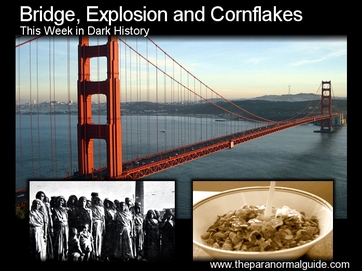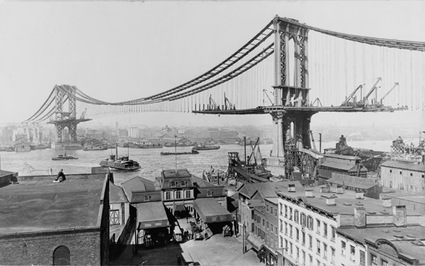
May 27, 1937
 Bridge under construction about 1935.
Bridge under construction about 1935. It was built to link the city of San Francisco to Marin County, in order to replace the ferry service that operated to transfer fresh water, cars, goods and passengers across the bay. The ferry trip took approximately half an hour, but people wanted a faster alternative, and one that was cheaper.
A bridge was suggested, but many thought it would be impossible across the 2,000 metre strait, and that the water was too deep with too strong currents.
However, in January 1933, construction began of the steel suspension bridge, and about four years later it was completed under schedule and under budget. More than 200,000 people on foot crossed the bridge at its grand opening, prior to it being opened to road traffic. San Francisco had its bridge and an icon to be proud of.
 Golden Gate Bridge today.
Golden Gate Bridge today. In 1936, Joseph Strauss, the engineer in charge of the bridges construction, declared the Golden Gate 'suicide proof'. He authorised a lower barrier along the bridge than was suggested, as it impeded the views of the bay. Two years later Strauss died of a heart attack, but by that time 6 people were known to have made the jump, ending their lives in the water 75 metres (25 stories) below.
Since the bridge was opened, more than 1500 people have suicided by jumping off the bridge. About one in 50 of the jumpers survive, but a few of those have returned and jumped a second time. Death is either when impact with the water occurs (hitting at about 120kms an hour), drowning or hypothermia.
The Golden Gate Bridge is the second most common site for suicide in the world.
May 28, 1965
 Children and wives look on for survivors.
Children and wives look on for survivors. As the ground shook, a massive explosion ripped through the mine, with fire and debris leaving via the open air shaft exits, sending coal dust several kilometres into the air. 275 miners underground were killed, as were 100 more above ground. Several homes in the area were also destroyed.
As people rushed to the site, in an effort to give aid to the survivors. large tracks of land sank, as sections of the mine collapsed. At the time it was India's largest loss of life in a mining accident, caused by explosion.
Although most accepted it as being an accident when a miner with a hurrcane lantern entered a section of the mine containing the gas pocket it was also suggested that it was an act of sabotage. There was no reason for the miner to have been in the section of the mine where the explosion occurred and that another explosive substance was used.
It has been told that after the accident, the mine and other mines about the area, resounded with the sounds of trapped and burning miners screams.
May 31, 1895
 John Harvey Kellogg.
John Harvey Kellogg. Being that many of his patients were those afflicted with long term, terminal and in many cases mental illnesses, a lot of the time he could only treat the symptoms, and what better way to do that than with a proper diet.
He believed that a vegetarian diet was the best way forward, any more exotic foods; especially those containing spices, could fire up the blood, increase passion and impulse, as well as the negative effects and illness associated with such emotions. Alcohol, coffee and caffeine were prohibited, and encouraged were foods that were bland and easy to digest.
He began to experiment with boiling grain, and processing it in a way that it could be rolled and toasted out as sheets of dough to be cut up and served as a substitute for bread. However, one experiment was interrupted as he had pressing matters at the sanitarium. On his return, the boiled wheat had cooled and gone stale. Still he rolled it out as budget was tight, and instead of a flattened dough, flakes were produced.
 The cereal we are familiar with.
The cereal we are familiar with. This might not sound like strange history at all until you consider this. Kellogg was an advocate for sexual abstinence, and discouraged all form of sexual activity, asides from its use for procreation. He worked to rehabilitate habitual and chronic masturbators, (which he believed was worse to humanity than plague, war and famine) and believed his flakes being bland were the ideal diet to help extinguish a person’s passions.
If this did not work then more dire practices were sought out, such as stitching closed a male’s foreskin, or applying acid to the female genitalia.





 RSS Feed
RSS Feed
